Caribbean Mixology for Beginners: Master Traditional Island Cocktail Techniques
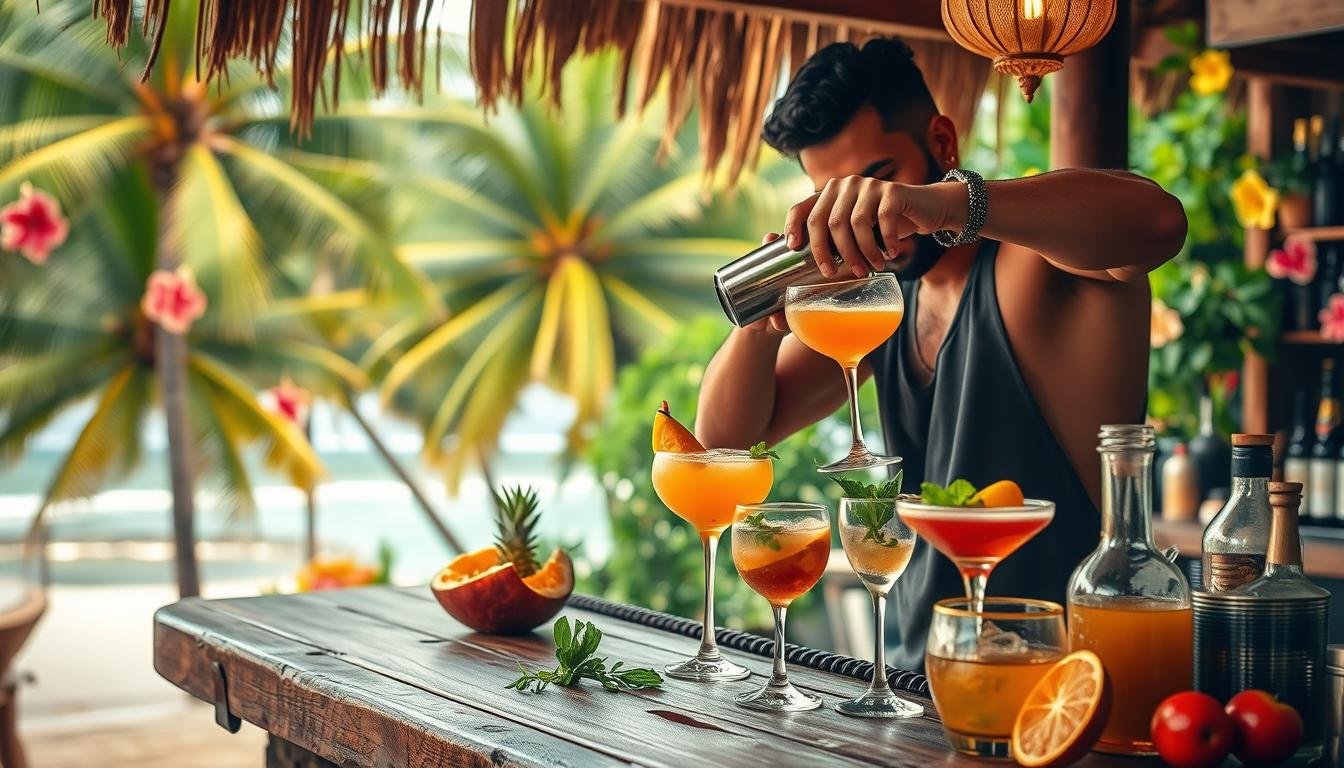
Do you remember that magical moment with a perfect rum punch by the sea? That explosion of tropical flavors on your tongue? I’ve been chasing that feeling for years. Now, I’m excited to help you make it at home!
My first trip to Jamaica was unforgettable. Watching a local bartender turn simple ingredients into liquid sunshine sparked my love for island cocktail crafting. After many beach trips and practice sessions, I’ve learned the best techniques from across the islands.
Tropical drinks are simple to make. You don’t need fancy tools or hard-to-find ingredients! With basic items and the right techniques, you’ll make drinks that feel like a trip to paradise.
In this guide, I’ll share my top tips for island bartending. We’ll dive into traditional methods passed down through generations. We’ll use fresh ingredients and proven combinations that always work!
Key Takeaways
- You can recreate authentic Caribbean cocktails at home with simple ingredients
- Traditional island techniques focus on balance, freshness, and proper mixing methods
- Most tropical recipes require only basic equipment you likely already have
- Understanding rum varieties is fundamental to mastering island drinks
- Fresh fruit juices and quality ingredients make all the difference in flavor
- Learning proper muddling and layering techniques creates professional results
Welcome to Paradise: Your Caribbean Cocktail Adventure Begins
Welcome to the magical world of Caribbean mixology. Here, making island drinks turns simple moments into paradise. These cocktails are more than drinks; they’re stories of culture and tradition.
I remember my first rum punch. It was a mix of exotic ingredients and precise amounts. But that first sip was amazing. That’s why I made this guide for you.
Setting up a tropical bar at home or expanding your cocktail skills is exciting. Caribbean mixology offers a unique experience. It’s a mix of sweet fruits, tangy citrus, and warm rum.
Don’t worry if you’re new. This guide will teach you step by step. You’ll learn to mix, layer, and master Caribbean mixed drinks.
You don’t need fancy tools or years of practice. Traditional methods are simple and effective. Many Caribbean bar recipes need just basic tools and fresh ingredients.
We’ll start with the history of these drinks. Then, we’ll explore the spirits and ingredients that make them special. By the end, you’ll know how and why these drinks are so great.
Are you ready to make your own paradise? Let’s explore the world of Caribbean mixology together!
The Fascinating History of Caribbean Cocktail Culture
Exploring Caribbean cocktails, I found their history is as rich as the drinks. Each sip tells a story of blending cultures, innovation, and tradition. Let’s explore the colorful past of tropical drinks we love today!
The Birth of Rum and Early Punch Traditions
The story of Caribbean cocktail history starts with rum. In the 1600s, plantation workers made a spirit from molasses, a sugar byproduct.
Early rum was harsh but cheap. It was popular among sailors and workers. They couldn’t imagine how it would change drinking worldwide.
The first traditional rum drinks were punch. British sailors mixed rum with citrus, sugar, spices, and water. This mix is still the base of Caribbean drinks today.
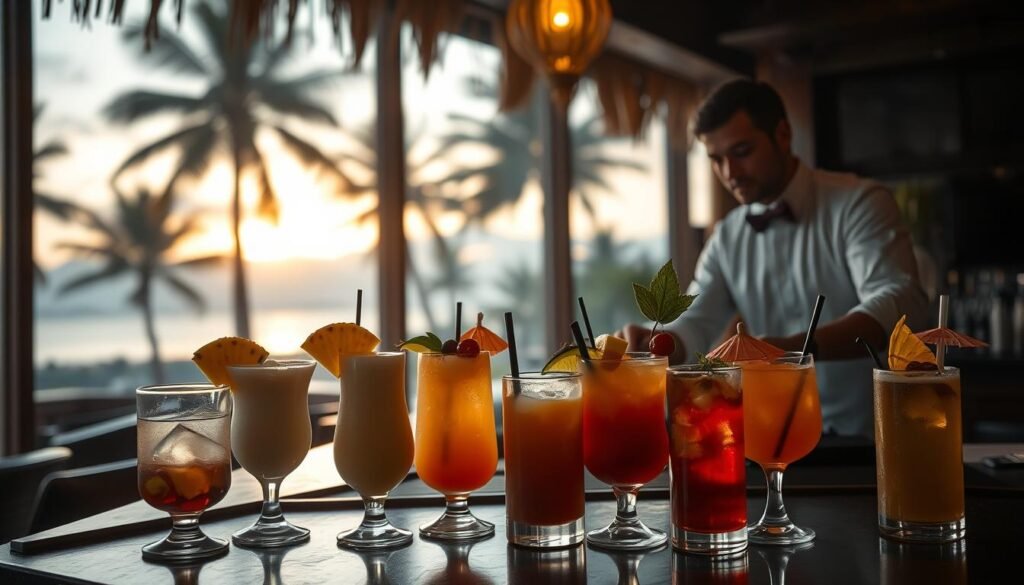
Colonial Influences on Island Drinking Culture
European colonizers brought their drinking traditions to the Caribbean. The British loved punch, while the Spanish favored aged spirits. French colonists improved rum production.
Dutch traders spread spirits and customs across the region. This mix created the diverse Caribbean cocktail culture we see today.
African Traditions in Caribbean Mixology
African influence on Caribbean mixology is vital but often overlooked. Enslaved Africans brought herbs, spices, and fermentation techniques. These changed island drinks forever.
They introduced hibiscus, sorrel, and roots that are still used today. Infusing spirits with herbs and spices has African roots.
Many Caribbean drinks have healing properties from African traditions. “Bush rum” was used for enjoyment and treating ailments. This holistic approach to drinking is still part of island culture.
The Golden Age of Caribbean Cocktails (1920s-1960s)
The 20th century was the golden age of Caribbean cocktails! American Prohibition sent bartenders to Cuba and other islands. This led to incredible innovation in tropical mixology.
Post-World War II tourism made Caribbean drinks popular worldwide. Tiki culture exploded in the United States. Classics like the Mojito and Daiquiri were born during this time.
Famous places like La Floridita in Havana became international cocktail spots. Ernest Hemingway’s love for Cuban daiquiris helped make the Caribbean famous for drinks. Rum distillery cocktails also gained recognition.
| Historical Period | Key Developments | Signature Drinks | Cultural Influences |
|---|---|---|---|
| 1600s-1700s | Birth of rum production | Navy Grog, Bumbo | British, Spanish colonial |
| 1800s | Refined distillation techniques | Planter’s Punch, Ti’ Punch | French, African traditions |
| 1920s-1940s | Prohibition-era innovation | Daiquiri, Mojito | American bartenders, Cuban influence |
| 1950s-1960s | Tourism boom, Tiki culture | Piña Colada, Mai Tai | International tourism, Polynesian fusion |
Knowing the history of Caribbean cocktails makes every drink more special. Mixing a Caribbean drink is more than just making a drink. It’s joining centuries of tradition!
Caribbean cocktails tell the story of the islands through flavor. Each ingredient is a chapter in a rich history. Next time you drink a rum punch or mojito, think about the journey it took to get to you!
Essential Caribbean Spirits and Liqueurs Every Beginner Needs
Ready to start your Caribbean bar collection? Let’s look at the key spirits for authentic island flavors at home! When I first mixed Caribbean cocktails, I felt lost with so many choices. But don’t worry, I’ll show you the must-haves to boost your mixology skills without spending too much!
Understanding Caribbean Rum Varieties and Styles
Rum is the heart of Caribbean spirits. Knowing the different styles will make your cocktails better right away! Each type adds its own special touch to your drinks.
White rums like Bacardi Superior or Havana Club are clear and crisp. They’re great for classics like daiquiris and mojitos. Their clean taste lets other ingredients stand out while providing a solid rum base. I always have a good white rum on hand for mixing!
Golden or amber rums age in oak barrels, gaining rich caramel and vanilla flavors. Brands like Appleton Estate from Jamaica or Mount Gay from Barbados are perfect for rum-based cocktails with more complexity. I love golden rum in punch recipes for that extra depth.
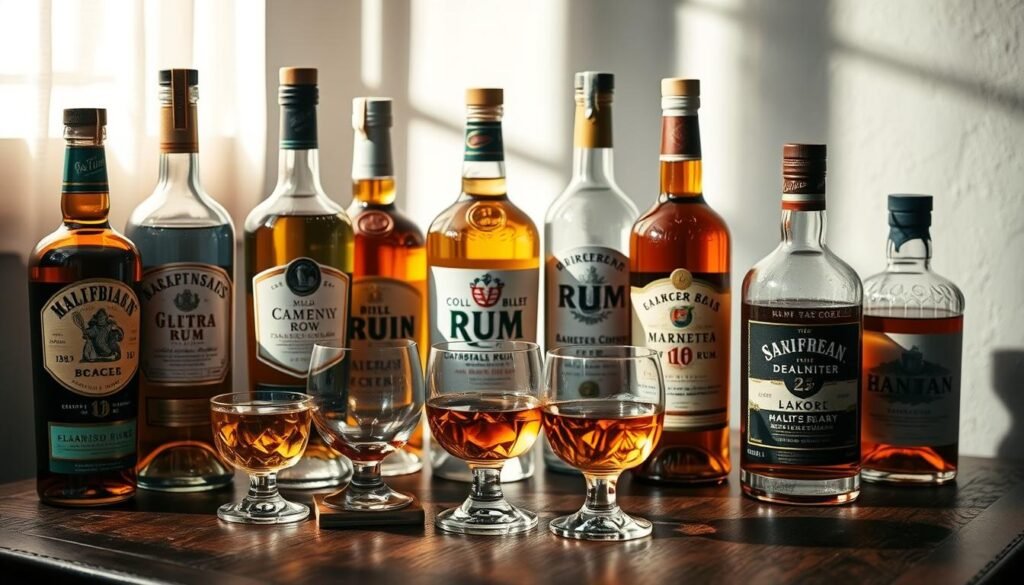
Dark rums like Gosling’s Black Seal or Myers’s have strong molasses flavors and deep color. They’re key for classics like the Dark ‘n Stormy or adding richness to tropical punches. The molasses notes make a great base for spiced rum cocktails.
Don’t miss out on rhum agricole from Martinique and Guadeloupe! Unlike most rums, agricole comes from fresh sugarcane juice. It has grassy, earthy flavors that make an amazing Ti’ Punch. It’s like tasting the sugarcane field in your glass!
Traditional Island Liqueurs and Cordials
Beyond rum, the Caribbean has amazing liqueurs that add real island character to your drinks. These sweet, flavorful additions are what give many cocktails their tropical vibe!
Coconut rum (usually around 24% alcohol) brings a vacation feel to any drink. Brands like Malibu are easy to find, but look for artisanal versions from the islands for more natural flavor and less sweetness.
Falernum is a Barbadian treasure I discovered years ago and now can’t live without! This spiced lime syrup liqueur adds notes of clove, almond, and ginger to cocktails. It’s essential for making authentic Corn ‘n Oil or Bermuda Rum Swizzle drinks.
Coffee liqueurs from Jamaica, like Tia Maria or Kahlúa (with Caribbean roots), add rich depth to creamy cocktails. Try adding a splash to a rum and coconut cream mixture for a delicious twist on traditional island flavors!
Local Spirits Beyond Rum: Cachaca, Aguardiente, and More
While rum is big in Caribbean mixology, exploring other regional spirits will open up new cocktail possibilities! These unique island spirits bring flavors you won’t find anywhere else.
Cachaça from Brazil (technically South American but with strong Caribbean influences) is made from fermented sugarcane juice. It’s the star of the famous Caipirinha cocktail and has a distinctive grassy, fruity profile that’s different from rum. I love introducing friends to this spirit – it’s always a hit!
Aguardiente from Colombia has anise notes that pair well with tropical fruits. The name literally means “burning water,” and while it packs a punch, it creates fascinating cocktails when mixed with citrus and sugar.
Guavaberry liqueur from St. Maarten offers unique berry flavors that aren’t common in mainstream spirits. It’s traditionally enjoyed during Christmas but makes great cocktails all year when paired with rum and lime.
Building Your Caribbean Bar on Any Budget
The best thing about creating a Caribbean rum collection? You don’t have to spend a lot! I always tell beginners to start with just three essential bottles:
First, invest in a quality white rum (around $15-20). This versatile spirit will be your base for mojitos, daiquiris, and countless other classics. Brands like Flor de Caña or Plantation 3 Stars offer excellent quality without breaking the bank.
Second, add a good golden rum ($20-25). This will add depth to your punches and stand up beautifully in stronger cocktails. Appleton Estate Signature Blend or Mount Gay Eclipse are perfect starting points.
Lastly, choose one island liqueur that intrigues you. Whether it’s coconut rum, coffee liqueur, or something more exotic, this will instantly add Caribbean character to your drinks.
From this foundation, you can gradually expand your collection as you discover your preferences. Remember – it’s better to have a few quality bottles than many mediocre ones! I started with just these basics years ago, and my cocktail journey has been delicious ever since.
Tropical Ingredients That Define Island Cocktails
Dive into the colorful world of Caribbean cocktail ingredients. Here, fresh tropical fruits, aromatic spices, and indigenous herbs create the authentic island experience! I’ve learned through years of mixing that the vibrant flavors of the Caribbean come alive when you use genuine ingredients. The difference between an ordinary drink and an extraordinary island cocktail often comes down to what you put in your shaker!
The beauty of Caribbean mixology lies in its simplicity and freshness. You don’t need fancy techniques when you have ingredients bursting with tropical character. Let me show you the essential components that will transform your home bar into a slice of paradise!
Fresh Citrus: Lime, Lemon, and Exotic Caribbean Fruits
If there’s one ingredient I consider absolutely non-negotiable in Caribbean cocktails, it’s fresh lime. That bright, zesty punch is the backbone of classics like mojitos, daiquiris, and every rum punch worth drinking! The acidity balances the sweetness of rum perfectly, creating that refreshing quality that makes island drinks so irresistible.
While lemons have their place, limes reign supreme in Caribbean mixology. I always squeeze them fresh – bottled juice simply can’t compare to that vibrant flavor and aromatic oils from the peel. One medium lime typically yields about an ounce of juice, which is perfect for most cocktail recipes.
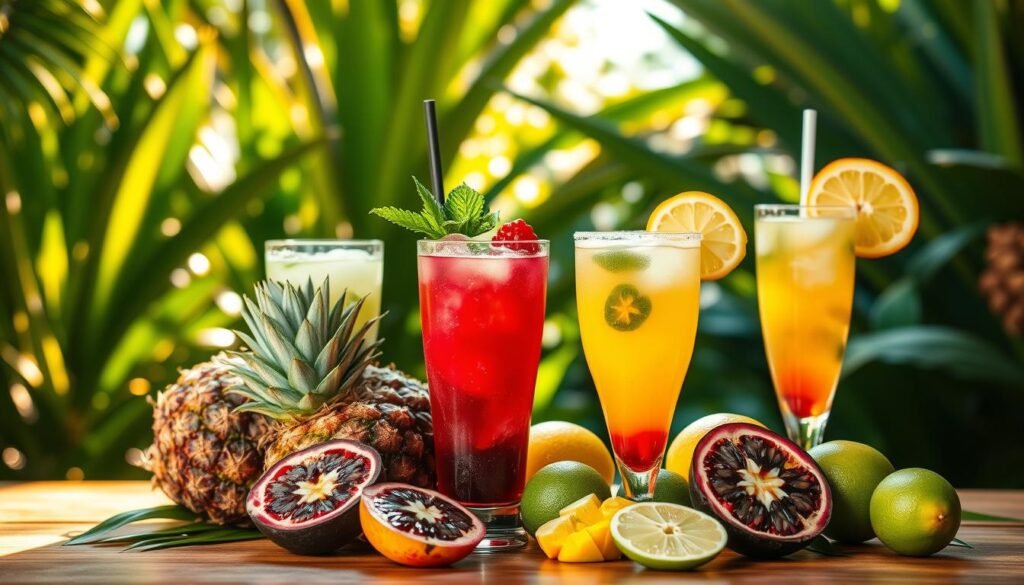
Beyond basic citrus, the Caribbean offers a treasure trove of exotic fruits that elevate cocktails to new heights. Passion fruit is my personal favorite – its intensely tangy, tropical flavor adds incredible complexity to rum drinks. Just a spoonful of fresh pulp transforms an ordinary cocktail into something special!
Don’t overlook other tropical gems like mango, pineapple, and guava. Each brings its unique character to island cocktail recipes. When fresh options aren’t available, look for pure fruit purees without added sugar – they’re the next best thing to fresh fruit and blend beautifully in tropical drinks.
Coconut Water, Cream, and Milk in Mixology
Coconut in all its forms is essential to Caribbean cocktail making! Each variation offers something unique to your drinks. Coconut water provides subtle sweetness and natural hydration, making it perfect for balancing stronger rum cocktails without overwhelming them.
For creamy tropical drinks like the famous Piña Colada, coconut cream is your go-to ingredient. It’s thicker and richer than coconut milk, creating that luxurious texture we all love. I always keep canned versions in my pantry, but if you can access fresh coconut, the flavor difference is remarkable!
Coconut milk works beautifully in punch recipes and lighter cocktails. It adds body without the heaviness of cream, creating a silky mouthfeel that carries tropical flavors perfectly. Try using it in place of dairy in your favorite creamy cocktail recipes for an instant Caribbean twist!
When shopping for coconut products, look for versions without added sweeteners or preservatives. The natural sweetness of coconut pairs perfectly with rum and tropical fruits without needing extra sugar. Your coconut cocktails will taste cleaner and more authentic!
Spices and Aromatics: Nutmeg, Cinnamon, and Allspice
The spice cabinet is just as important as the bar when crafting authentic Caribbean cocktails! These aromatic ingredients add depth and complexity that transform simple drinks into memorable experiences. Freshly grated nutmeg is the traditional finishing touch for many rum punches – that aromatic dusting on top is unmistakably Caribbean.
Cinnamon brings warming notes that complement aged rums beautifully. I love adding a cinnamon stick as both garnish and flavor enhancer – it looks impressive and infuses gentle spice as you sip. For an authentic touch, look for Ceylon cinnamon, which has a more delicate flavor than the common cassia variety.
Allspice (pimento) actually originates from Jamaica and features prominently in many island recipes. Its complex flavor combines notes of cinnamon, nutmeg, and cloves – perfect for adding depth to tropical cocktails. You can use it ground or as whole berries steeped in syrups.
Don’t forget vanilla, which grows throughout the Caribbean and adds wonderful roundness to cocktails. A split vanilla bean steeped in rum creates an incredible infusion for elevated tropical drinks. Even a few drops of pure extract can enhance fruit flavors in your island cocktail recipes.
Fresh Herbs: Mint, Basil, and Indigenous Island Plants
Fresh herbs elevate Caribbean cocktails from good to unforgettable! Mint is the star of mojitos, of course, but its refreshing quality works wonderfully in countless rum drinks. The key is to handle it gently – a light muddle releases the essential oils without bitter flavors from the leaves.
Basil might seem unexpected, but it pairs surprisingly well with tropical fruits. Its slightly peppery, aromatic quality creates fascinating complexity when combined with mango or passion fruit. I love using Thai basil varieties when I can find them – they have hints of anise that complement rum beautifully.
Throughout the Caribbean islands, indigenous plants have been used in drinks for generations. Sorrel (hibiscus) creates a vibrant ruby-colored base for punches with its tart, cranberry-like flavor. Lemongrass adds citrusy notes without acidity, while bay leaf brings subtle complexity to spiced rum drinks.
Even if you can only find a few of these authentic ingredients, using them fresh rather than relying on bottled mixers will transform your cocktails into genuine Caribbean experiences! The vibrant flavors of real ingredients capture the essence of island life in every glass – and isn’t that what tropical cocktails are all about?
Traditional Caribbean Mixology Techniques Explained
Let me share the traditional Caribbean bartending techniques that completely transformed my home cocktail game and will do the same for yours! These simple methods can create complex flavors. You don’t need fancy equipment or years of experience to master these island bartending skills!
The Art of Muddling: Releasing Maximum Flavor
Muddling is one of my absolute favorite Caribbean bartending techniques! But there’s definitely a right way to do it. The goal isn’t to pulverize your ingredients into oblivion—it’s to gently coax out their essential oils and juices.
When muddling mint for a classic mojito, I use gentle pressure with a twisting motion to release those aromatic oils without tearing the leaves. Torn mint releases bitter compounds that can ruin your drink! For fruits like lime, I apply slightly more pressure to extract both juice and the flavorful oils from the peel.
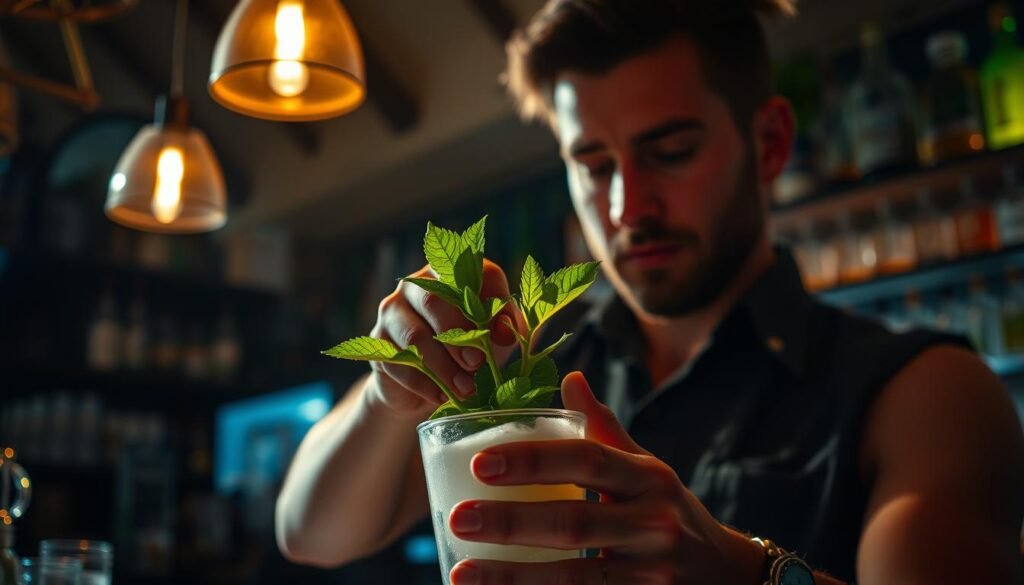
A wooden muddler works best for most tropical mixology applications. The flat-bottomed ones are perfect for herbs, while slightly textured muddlers work wonders on fruits. Always muddle in a sturdy glass or the bottom of your shaker—thin glasses can crack under pressure!
Layering Techniques for Beautiful Gradient Cocktails
Those gorgeous sunset-colored drinks you see in Caribbean bars aren’t just for show—they’re a demonstration of precise layering technique! The science is simple: liquids with different sugar contents have different densities, allowing them to stack on top of each other.
To create beautiful layers like a true Caribbean bartender, always pour the heaviest (usually sweetest) liquids first. Then carefully pour lighter ingredients over the back of a bar spoon, allowing the liquid to gently flow down the side of the glass. This prevents mixing and creates those stunning gradient effects!
My favorite layered drink is the Bob Marley shot, which uses grenadine, crème de menthe, and banana liqueur to create Jamaica’s flag colors. The trick is pouring slowly and having a steady hand—practice makes perfect!
Traditional Shaking vs. Stirring Methods
Knowing when to shake versus stir is crucial for perfect texture in your Caribbean cocktails. I follow this simple rule: shake anything with fruit juices, syrups, or dairy to properly emulsify and aerate the ingredients.
A good shake with ice for 10-15 seconds creates the perfect dilution and chill! When shaking, hold both parts of your shaker firmly and shake horizontally with a rhythm—not up and down. You’ll know you’ve shaken enough when the outside of the shaker becomes frosty.
For spirit-forward drinks like the El Presidente (a Cuban classic), stirring maintains clarity and provides a silky texture. Stir gently in a mixing glass with ice for about 30 seconds, moving the bar spoon around the perimeter of the glass. These island bartending skills take practice but make a huge difference in your final drink!
The Caribbean Punch Formula: Sweet, Sour, Strong, Weak
The traditional Caribbean punch formula is something I use constantly: “One of sour, two of sweet, three of strong, four of weak.” This time-tested ratio creates perfectly balanced large-format drinks every time!
In this classic formula, “sour” refers to citrus juice (usually lime), “sweet” is sugar or syrup, “strong” is rum (of course!), and “weak” is water or ice. Dating back to the 17th century, this formula remains the foundation of island mixology techniques today.
I love how flexible this formula is! You can substitute different citrus for the sour component, experiment with various sweeteners, try different rum blends, and adjust the dilution to suit your taste. It’s foolproof for creating balanced punches for any gathering!
| Technique | Best Used For | Common Mistakes | Pro Tips |
|---|---|---|---|
| Muddling | Mojitos, Caipirinhas, Mint Juleps | Overmashing ingredients, causing bitterness | Use gentle pressure and a twisting motion for herbs |
| Layering | Bob Marley shots, Rainbow Punch, Tequila Sunrise | Pouring too quickly, disrupting layers | Pour slowly over the back of a spoon against the glass |
| Shaking | Daiquiris, Piña Coladas, anything with juice | Weak shaking, insufficient chilling | Shake horizontally until shaker becomes frosty |
| Stirring | El Presidente, rum Old Fashioneds | Stirring too vigorously, creating bubbles | Stir gently around the perimeter for 30 seconds |
| Punch Formula | Planter’s Punch, Fish House Punch | Incorrect proportions, unbalanced flavor | Follow the 1:2:3:4 ratio and adjust to taste |
Mastering these tropical mixology techniques will elevate your home bartending instantly! I’ve found that practicing each method with simple recipes first helps build confidence before tackling more complex Caribbean cocktails. Remember, even professional bartenders started as beginners—the key is practice and having fun along the way!
Regional Cocktail Specialties Across the Islands
The Caribbean is full of different cocktail cultures. Each island has its own special drinks. These drinks show off the island’s history, ingredients, and culture.
Let’s explore the must-know cocktails from each island paradise!
Cuban Classics: Mojito, Daiquiri, and Cuba Libre Mastery
Cuba is the cocktail king of the Caribbean. Its mixing tradition goes back centuries. During Prohibition, Americans came to Havana for legal drinks.
The Mojito is Cuba’s favorite drink. It’s made with white rum, lime, mint, sugar, and soda. The secret is muddling the mint just right.
The Daiquiri is another Cuban favorite. It has white rum, lime juice, and sugar. It’s shaken and strained into a glass. No blenders or fake flavors!
The Cuba Libre is simple but special. It’s rum, cola, and lime. It celebrates Cuban independence and shows how simple drinks can be complex.
Jamaican Favorites: Rum Punch, Planter’s Punch, and Bob Marley
Jamaica is known for its bold rum flavors. The island’s rums have tropical fruit notes and rich complexity.
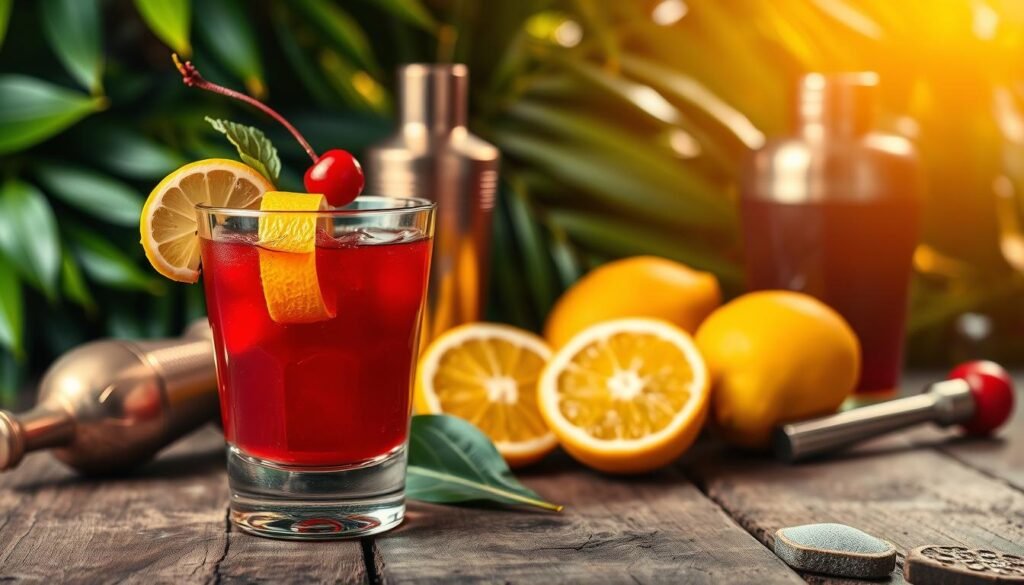
Jamaican Rum Punch is a classic. It’s made with dark rum, lime, sugar, and water. It’s garnished with nutmeg.
Planter’s Punch comes from Jamaican plantations. It’s made with dark rum, lime, sugar, and bitters. It’s often garnished with grenadine.
The Bob Marley is a modern shot. It has green, yellow, and red layers. It celebrates Jamaican culture.
Puerto Rican Perfection: Piña Colada and Coquito Techniques
Puerto Rico is where the Piña Colada was born. It’s a creamy mix of rum, coconut, and pineapple. The Caribe Hilton in San Juan created it in 1954.
The secret to a great piña colada is blending it just right. Too long and it’s warm and watery. 10-15 seconds is perfect.
Coquito is a holiday drink in Puerto Rico. It’s a coconut eggnog with rum, coconut milk, and spices. It’s a festive tradition.
Barbadian and Lesser Antilles Signature Drinks
Barbados is the birthplace of rum. They have unique cocktails like the Corn ‘n Oil. It’s a mix of blackstrap rum, falernum, and lime juice.
Martinique is famous for Ti’ Punch. It’s made with rhum agricole, lime, and cane syrup. Guests mix their own drink.
Trinidad has the Queens Park Swizzle. It’s a minty drink with dark rum, mint, lime, sugar, and Angostura bitters. It’s swizzled, not stirred.
These drinks show the diversity of Caribbean cocktails. By learning the authentic ways, you can bring the Caribbean to your home bar. Each drink tells a story of place and culture.
15 Essential Caribbean Cocktails Every Beginner Should Master
Let’s explore the vibrant world of Caribbean mixology. You’ll learn 15 essential cocktails to become an island bartender! These drinks are not just tasty. They teach you tropical techniques, flavors, and traditions.
I picked these recipes because they build skills for many other cocktails. They also give you that authentic Caribbean feel!
Perfect Cuban Mojito (Traditional Method)
The mojito is refreshing and teaches you about muddling and layering flavors. Start with a sturdy highball glass. Muddle 2 teaspoons of sugar, half a lime’s juice, and 8-10 fresh mint leaves gently.
Add 2 ounces of quality white rum, crushed ice, and a splash of soda water. Finish with a mint sprig “spanked” between your palms. This wakes up the mint’s fragrance without bitterness.
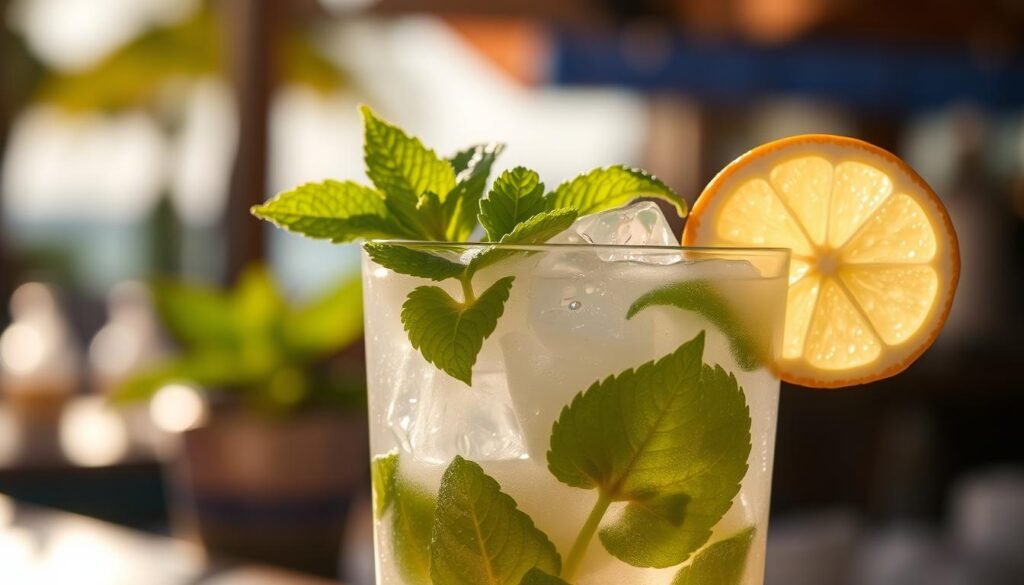
Classic Jamaican Rum Punch
This traditional punch bowl favorite is a Caribbean classic. It’s perfect for caribbean party drinks and lets you enjoy your guests.
For 8-10 people, mix 2 cups fresh lime juice, 4 cups simple syrup, 6 cups Jamaican rum, and 8 cups water or ice. Add Angostura bitters and nutmeg for that island touch.
The beauty of punch is its flexibility. Adjust sweetness or strength to your liking. It’s great for creating an island happy hour vibe without being stuck behind the bar!
Authentic Puerto Rican Piña Colada
Forget the sweet mixes! The real Puerto Rican piña colada is balanced and creamy. Blend 2 ounces white rum, 1 ounce dark rum, 3 ounces pineapple chunks, 1 ounce pineapple juice, and 1 ounce cream of coconut.
Add 1/2 cup ice and blend until smooth. The traditional method uses a blender for that velvety texture. Pour into a hurricane glass and garnish with a pineapple wedge and cherry.
This authentic piña colada is creamy and sweet but has enough rum character. Fresh pineapple makes all the difference.
Traditional Dark ‘n’ Stormy from Bermuda
The Dark and Stormy is legally protected. Use Gosling’s Black Seal Rum for the real deal. This drink teaches you to build cocktails in the glass.
Fill a tall glass with ice, add 2 ounces of Gosling’s Black Seal Rum, and top with spicy ginger beer. Garnish with a lime wedge for extra brightness.
The technique is about layering. Pour ginger beer first, then rum over the back of a spoon. This creates a storm cloud effect.
Beyond these four classics, master these additional Caribbean essentials:
- Classic Daiquiri – The shaken mix of white rum, lime juice, and sugar made famous by Ernest Hemingway
- Cuba Libre – More than rum and cola, it includes fresh lime juice and a specific method
- Bahama Mama – A fruity blend that teaches balancing multiple rums with fruit juices
- Painkiller – The Pusser’s Rum signature with coconut cream, pineapple, and orange juice
- Corn ‘n Oil – A Barbadian classic with blackstrap rum and falernum
Master the Mai Tai, Planter’s Punch, Barbados Rum Punch, Ti’ Punch, Coco Loco, and the Hurricane. Each teaches different techniques and expands your flavor repertoire! For more inspiration, check out these classic rum drinks that have stood the test of time.
The true spirit of Caribbean mixology is understanding the classics. Start with these 15 essentials for a solid foundation for endless tropical creations!
Mastering Caribbean Cocktail Equipment and Tools
Setting up your island bar doesn’t need to be expensive. Just a few key tools can make you a Caribbean pro! I’ve learned a lot about island bar setup over the years. And the best part? You can make authentic Caribbean cocktails without spending a lot.
Essential Bar Tools for Caribbean Mixology
First, you need a good shaker for your Caribbean cocktails. I like a two-piece Boston shaker. It’s big for batch recipes and doesn’t freeze up with ice.
A Hawthorne strainer is next. It catches small bits of fruit or herbs. Also, get a jigger for measuring spirits and mixers. Precision is key in Caribbean mixology.
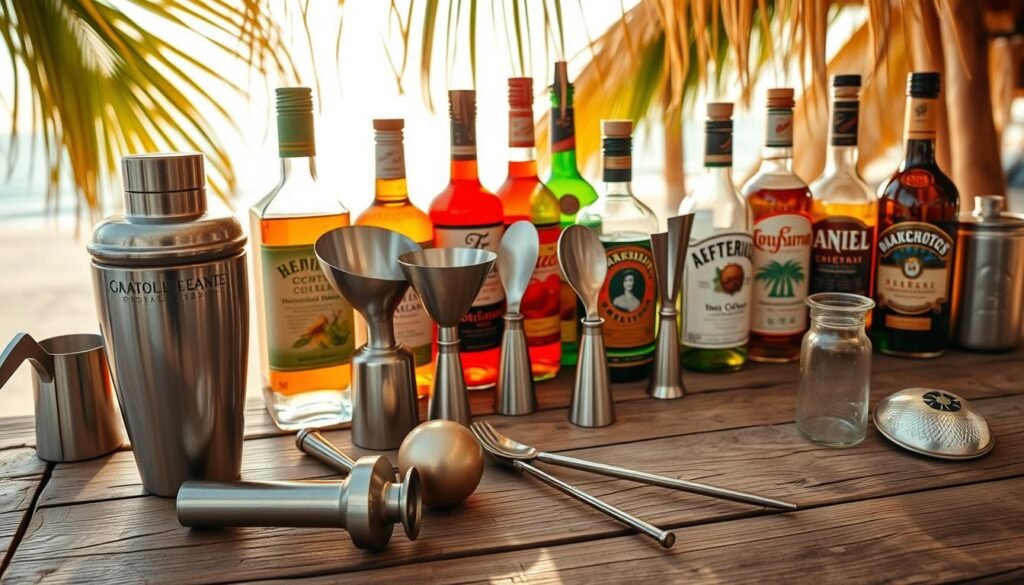
A quality muddler is important. Wooden ones are gentle on glass and great for mojitos or punch recipes. A long bar spoon is also essential for stirring and layering drinks.
Lastly, a citrus juicer saves time and effort. Fresh juice makes a big difference in Caribbean cocktails.
Traditional vs. Modern Equipment Choices
Caribbean mixology mixes old and new. Traditional tools carry cultural value. A swizzle stick, for example, froths drinks when spun.
Punch bowls are another evolution. Traditional ones are beautiful but pricey. A large glass bowl works well for serving rum punch.
For blended drinks, electric blenders are common. But, many still prefer hand-muddling for texture and flavor.
DIY Solutions for Specialty Caribbean Cocktail Tools
True Caribbean hospitality means being creative. No muddler? Use a wooden spoon handle. No jigger? A standard shot glass is about 1.5 ounces.
Need a swizzle stick? A chopstick with fork tines works. For straining, a small tea strainer is a good substitute.
Without a shaker? A protein shaker bottle or mason jar works. Just make sure it seals well.
For serving, use coconut shells or pineapples for presentation. But regular glassware works too. Highballs for tall drinks, rocks glasses for rum old-fashioneds, and hurricane glasses for punches.
The most important thing in your tropical bar recipes is quality ingredients and technique. With these tools and ideas, you’ll make Caribbean cocktails like a pro!
Understanding Caribbean Cocktail Balance and Flavor Profiles
Creating authentic island drinks is all about flavor balance. I’ve spent years perfecting my tropical cocktail recipes. The difference between a good drink and a great one is balance. Caribbean cocktails mix flavors that take you to a beach at sunset!
The perfect island cocktail recipe is more than just mixing ingredients. It’s about creating a taste experience that feels like the Caribbean. Whether you’re making refreshing Caribbean summer drinks or elegant sunset drinks, knowing how to balance flavors is key.
The Science of Balancing Sweet, Sour, and Bitter
Caribbean cocktails balance sweet, sour, bitter, and strong flavors. Our taste buds experience these flavors together. When balanced, it’s magic!
Sweetness is the base, from sugar syrups to Caribbean liqueurs. But too much is too sweet. That’s why sour elements like lime or lemon juice are added.
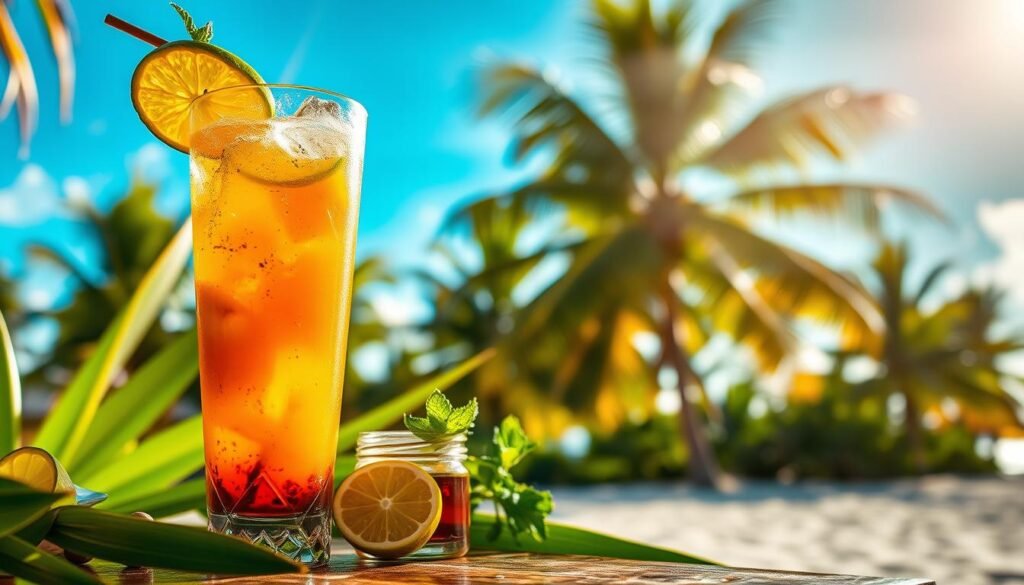
Bitterness adds depth. A few dashes of bitters or grapefruit juice can make a drink sophisticated. Taste as you go and adjust to your liking.
Working with High-Proof Rums and Strong Spirits
High-proof rums are a Caribbean staple. But they can overpower if not used right. The trick is to dilute them with ice and mixers.
When using strong rum, start with less than you think. I often use a third less than regular rum. Pouring the rum on top creates a strong aroma and lets flavors mix as you drink.
This method is perfect for sunset drinks. The rum’s aroma hits you first. Remember, the drink will change as the ice melts.
Incorporating Heat: Peppers and Spices in Cocktails
Heat is a key part of Caribbean cocktails. Scotch bonnet peppers add a unique flavor. But too much heat can ruin the drink.
I make pepper-infused simple syrup by simmering a pepper in sugar syrup. This lets me control the spice level in my Caribbean summer drinks. Start with a little and add more if needed.
Spices like ginger and cinnamon add warmth. Muddling fresh ginger in the glass adds a nice heat. This warmth balances with the cold of ice and fruit juices.
Temperature affects how we taste flavors. Cold drinks can hide sweetness. So, frozen drinks might need more sweetener. If your drink is spicy and over ice, you might need more heat.
Seasonal Caribbean Cocktails and Holiday Traditions
Caribbean cocktails change with the seasons. They tell stories of island celebrations. Each season brings new flavors and traditions.
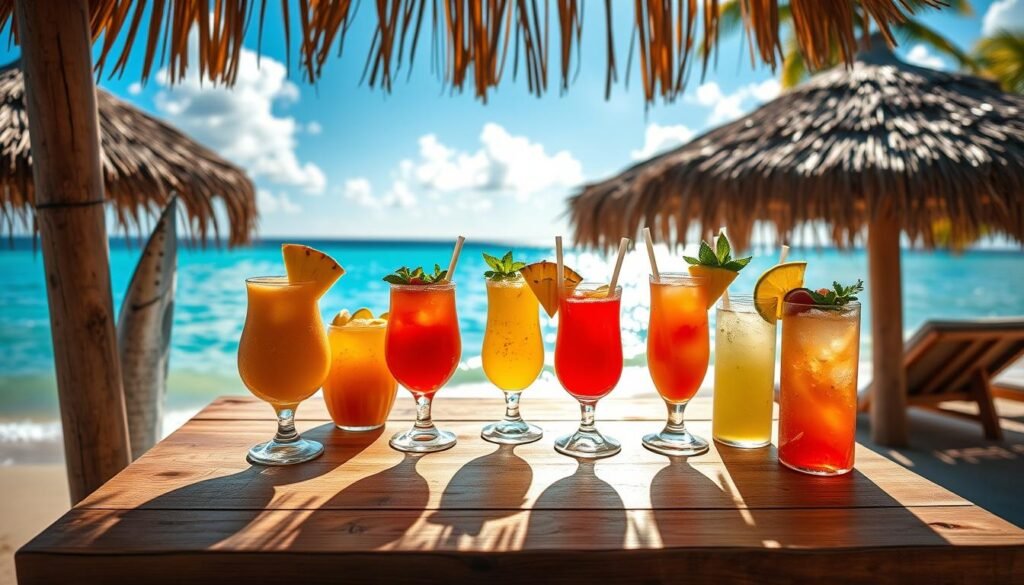
Christmas and New Year Celebration Drinks
The holiday season in the Caribbean is special. It brings favorite cocktail traditions. These drinks warm the spirit and unite families.
Coquito from Puerto Rico is a coconut eggnog. It’s a holiday staple. It mixes coconut cream with spices like cinnamon and rum for a holiday kick.
Jamaica’s Sorrel Drink is another must-have. It’s made from hibiscus flowers, ginger, and rum. Its sweet-spicy flavor is perfect for Christmas.
In Trinidad and Tobago, Ponche de Crème is essential. It’s a creamy mix of eggs, milk, and rum. It’s sweet and warming, perfect for chilly evenings.
Carnival and Festival Cocktail Traditions
Carnival season is full of energy. The cocktails match this spirit with bold flavors. They keep the party going.
Rum Punch is a Carnival star. Each island has its own twist. Trinidad’s Punch a Crème is a strong mix of condensed milk and rum.
The Bahamas’ Goombay Smash is a Carnival favorite. It’s a mix of coconut rum and fruit juices. Bartenders make it with flair.
Festival drinks are colorful and strong. They’re made with local fruits. The Bahama Mama and Carnival Rum Runner showcase the islands’ bounty.
Summer Cooling Drinks and Winter Warming Cocktails
Caribbean bartenders adjust their recipes with the seasons. They create cooling summer drinks and warming winter cocktails.
For hot days, a Mojito or Daiquiri is refreshing. They use ice, lime, and a bit of sweetness. Frozen Piña Colada is also great for cooling down.
Sunset drinks are perfect for the transition from day to night. Planter’s Punch looks like a sunset. The Painkiller is refreshing and complex.
In winter, cocktails are warmer. Hot Buttered Rum gets a tropical twist. Spiced Rum Toddy combines honey and spices. The Atomic Navy Nog is a holiday treat with rum and brandy.
| Season | Signature Cocktail | Key Ingredients | Serving Style | Celebration |
|---|---|---|---|---|
| Christmas | Coquito | Coconut cream, rum, cinnamon, nutmeg | Chilled in small glasses | Family gatherings |
| Carnival | Rum Punch | Multiple rums, tropical juices, bitters | Large batches in cups | Street parades |
| Summer | Frozen Daiquiri | Light rum, lime, sugar, crushed ice | Blended in hurricane glass | Beach parties |
| Winter | Spiced Rum Toddy | Dark rum, honey, citrus, cloves | Warm in mug | Evening relaxation |
Caribbean cocktails connect people to cultural moments. They’re more than drinks; they’re a way to preserve island heritage. Each sip tells a story of celebration and community.
Troubleshooting Common Caribbean Cocktail Mistakes
Mastering Caribbean mixology is more than just following recipes. It’s about knowing how to fix mistakes. I’ve worked in tropical bars for years. Even pros make mistakes with rum-based cocktails. But, most problems have simple fixes that save your drink!
Let’s look at common issues in caribbean bartending and how to fix them. With these tips, you’ll be ready for any cocktail emergency!
Fixing Over-Sweet or Under-Balanced Drinks
The biggest problem at tropical bars is drinks that are too sweet. Caribbean cocktails often have sweet syrups and juices. If not balanced, they can be overwhelming.
If your drink is too sweet, don’t worry. Just add more citrus juice, like fresh lime. If adding more liquid makes your glass too full, pour some out first. Then add the lime juice. This trick works great for rum punches and daiquiris.
For drinks that are too dry, don’t just add simple syrup. Think about which sweet element will fit your flavors. A bit of fruit liqueur can add sweetness and depth to your caribbean mixed drinks.

Remember, temperature affects how sweet a drink tastes. A cold cocktail might taste sweet when it warms up. So, chilling and serving techniques are key in island mixology techniques.
Preventing Separation in Cream-Based Cocktails
Nothing’s worse than a Piña Colada that separates. Cream-based Caribbean cocktails need special care to stay smooth.
The trick is to emulsify the ingredients properly. Shake all ingredients except ice for about 20 seconds. This mixes the fats well. Then, add ice and shake again to cool.
Using cream of coconut instead of coconut milk helps prevent separation. If your drink still separates, a quick re-blend or shake fixes it. For the best coconut cream cocktails, mix ingredients at room temperature. Cold cream clumps instead of blending smoothly into your rum-based cocktails.
Adjusting Alcohol Strength for Different Preferences
Caribbean cocktails, with their strong rum, can be quite potent. Adjusting the alcohol strength is key in caribbean bartending.
Start with the traditional recipe, then adjust based on what guests like. To make drinks weaker, add more mixers. For example, add more pineapple juice and cream to a Piña Colada.
For stronger drinks, float a bit more rum on top. This lets guests control their drink’s strength. Dark rum also adds color to many caribbean mixed drinks!
Here’s a quick guide for common Caribbean cocktail problems:
| Common Problem | Likely Cause | Quick Fix | Prevention Tip |
|---|---|---|---|
| Overly sweet cocktail | Too much syrup or liqueur | Add fresh lime juice | Measure ingredients precisely |
| Separating cream drinks | Insufficient emulsification | Re-blend or dry shake again | Dry shake for 20+ seconds before adding ice |
| Too strong/alcoholic | Heavy-handed rum pour | Add more mixer proportionally | Use a jigger for accurate measurements |
| Watery cocktail | Over-dilution from ice | Add a splash more of primary spirit | Shake quickly and serve immediately |
| Bitter aftertaste | Citrus pith or over-muddling | Balance with a touch more sweetener | Muddle gently and avoid citrus pith |
Other common issues include drinks that are too diluted, too cold, or out of balance. The best island mixology techniques involve tasting and adjusting as you go.
Fixing mistakes is part of getting better at mixology. Even top tropical bars have to troubleshoot sometimes. Each fix teaches you something about flavor and ingredients.
With these tips, you’ll be ready for any Caribbean cocktail emergency. Cheers to becoming a more confident island mixologist!
Presentation and Garnishing Like a Caribbean Pro
The final touch to any amazing beach cocktail is all about presentation! Caribbean hospitality shines through beautiful garnishes. These garnishes turn ordinary drinks into Instagram-worthy creations. Let’s explore how to finish your tropical drink recipes with authentic island flair!
Traditional Caribbean Garnish Techniques
The “spanking” technique is my go-to method for herbs! Just place mint leaves in your palm and gently clap once. This releases aromatic oils without bruising. This simple trick adds incredible fragrance to your drinks!
Fruit shells make stunning natural vessels for tropical drink recipes. Hollowed pineapples, coconut halves, and carved watermelons aren’t just pretty. They actually infuse subtle flavors into your cocktails!
Citrus garnishes come in many forms in the Caribbean. Try “flags” (folded citrus slices on picks), wheels, or twists. The oils in the peel add both color and aroma that complete the drinking experience.
Edible flowers bring vibrant island color to any island cocktail party. Hibiscus, orchids, and bougainvillea create that authentic tropical vibe. Just make sure they’re food-safe!
Don’t forget that Caribbean garnishes serve dual purposes – they look beautiful and enhance flavor. A sprinkle of freshly grated nutmeg or cinnamon atop your drink adds both visual appeal and wonderful aroma.
The right glassware matters too! Traditional vessels like hurricane glasses, tiki mugs, or coconut shells complete the presentation. These little touches transform ordinary moments into unforgettable island experiences!